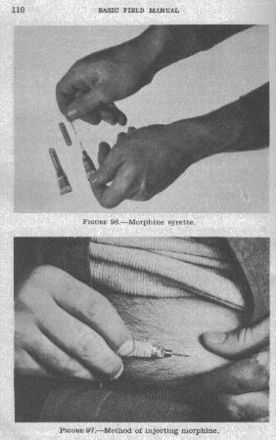- Syrette
-
The Syrette is a device for injecting liquid through a needle. It is similar to a syringe except that it has a closed flexible tube (like that used for toothpaste) instead of a rigid tube and piston. It was developed by Squibb, now the Bristol-Myers Squibb Company.
The morphine syrette used in World War II had a wire loop pin with a guard in the end of the hollow needle that was used to break a seal where the needle was attached to the tube. It was similar to a Superglue tube. After breaking the seal the wire loop pin was removed and the hollow needle was inserted under the skin at a shallow angle and the tube flattened between the thumb and fingers. (See subcutaneous injection.) After injection the used tube was pinned to the receiving soldier's collar to inform others of the dose administered.
The US Military also distributed atropine in syrettes. Chemical treatment was subsequently distributed in Autoinjector form.
-
Syrette of morphine from WWII. On display at the Army Medical Services Museum.
External links
- morphine syrette described at the "Saving Private Ryan" online encyclopedia
Routes of administration / Dosage forms Oral - Mouthwash
- Toothpaste
- Ointment
- Oral spray
- Oxygen mask
- Oxygen concentrator
- Anaesthetic machine
- Relative analgesia machine






Ocular / Otologic / Nasal - Nasal spray
- Ear drops
- Eye drops
- Ointment
- Hydrogel
- Nanosphere suspension
- Mucoadhesive microdisc (microsphere tablet)
Urogenital - Ointment
- Pessary (vaginal suppository)
- Vaginal ring
- Vaginal douche
- Intrauterine device (IUD)
- Extra-amniotic infusion
- Intravesical infusion
Rectal (enteral) - Ointment
- Suppository
- Enema (Solution • Hydrogel)
- Murphy drip
- Nutrient enema
Dermal Injection / Infusion
(into tissue/blood)- Intracavernous
- Intravitreal
- Intra-articular or intrasynovial injection
- Transscleral
- Intracerebral
- Intrathecal
- Epidural
Additional explanation: Mucous membranes are used by the human body to absorb the dosage for all routes of administration, except for "Dermal" and "Injection/Infusion".
Administration routes can also be grouped as Topical (local effect) or Systemic (defined as Enteral = Digestive tract/Rectal, or Parenteral = All other routes).Routes of administration by organ system Gastrointestinal Respiratory system Pulmonary • NasalVisual system / Auditory system Reproductive system Intracavernous • Intravaginal • Intrauterine (Extra-amniotic)Urinary system IntravesicalPeritoneum Central nervous system Circulatory system Musculoskeletal system Skin Categories:- Medical equipment
- Drug delivery devices
Wikimedia Foundation. 2010.





